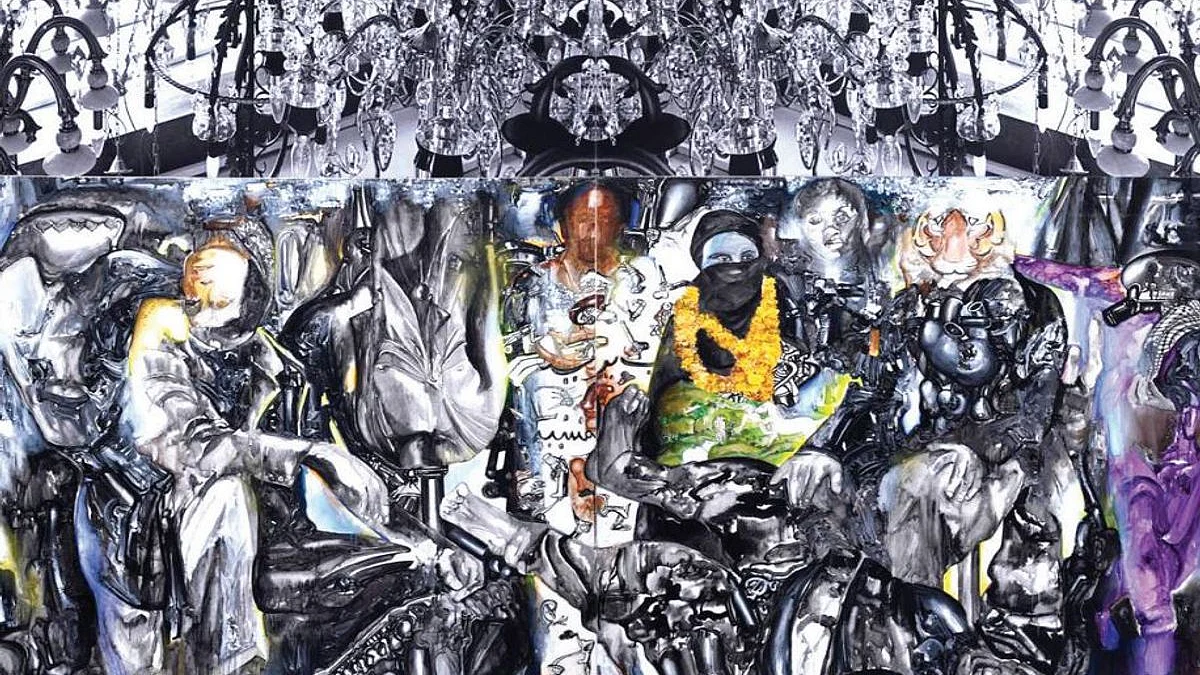Staging the inexorability of death
The Mayapuri dump, a local node in the larger global military industrial complex, has engaged artist Probir Gupta for some time now

The Delhi smog, now an annual affair, has shone a light on industries and localities that have for years functioned under the radar. Unregulated industrial units on the city’s western peripheries where vast quantities of toxic materials are handled everyday are now under the scanner for being a major source of the pollution that is increasingly penetrating the city’s more affluent swathes. One such industrial district is in West Delhi’s Mayapuri, home to what is reputed to be one of the largest scrap markets in Asia, where in 2010, a labourer was killed and several others taken ill in a serious incident of radiation poisoning.
The Mayapuri dump, a local node in the larger global military industrial complex, has engaged artist Probir Gupta for some time now. Mayapuri and its metal waste loom large in Gupta’s works as the spectre of toxicity banished comes back to make over the world in its own image. But Mayapuri also provides another model, of resurrection and remodeling that which is condemned, decrepit and in disuse. In Family is Plural, a new exhibition of solo works by Gupta curated by Shaheen Merali, the desire to remake is acute and the object of the makeover a humanity beleaguered and besieged.
It is not uncommon, in our fractious times, to come across violence in art but rarely does one encounter it in such explicit, visceral detail as in the work of Gupta. The works form a piece with his wider oeuvre comprising large scale canvases overlaid with vigorous impasto and sculptural assemblages constructed from varied waste materials. In the present exhibition, dedicated to unfolding the manifold political and social crises erupting across the world, the artist’s signature style lends itself to a larger period style of the contemporary.
Gupta is known for creating vast visual palimpsests, where history adheres in a chaos of images and signs rather than in neat striation. Three such history paintings stand out here — Indian Tempest after Nirbhaya and the Arab Spring (2013-15), Sacred Cows and Surrogate Mothers (2018), and Iconising Blacks and Dalits (2017-18) — with the last two decades in the life of Indian polity mapped in riotous collage. Gupta mixes different media and modes, press images jostling against the popular iconography of the Indian street and Gupta’s own painterly insertions, the collective impact of which is a vertiginous assault on the senses and a corresponding jolt to the conscience. There is also a deliberate - some might say indiscriminate - miscegenation of disparate art historical references and genres, as in the monumental Iconising Blacks and Dalits where a Renaissance-style painting of the apostles meets the twentieth century Soviet art of public murals and mosaics. But this indicates not so much postmodern ahistoricity as an attempt to grapple with the baggage of too much history.
If Gupta’s canvases evince an almost oppressive burden of detail, his installations disclose the impossible precarity of life and labour under the prevailing dispensation of global media and capital. In the dramatic Underground Radio (2019), an abandoned dentist’s chair is ensconced in the skeletal maw of some ancient behemoth, while the spokes and mics of sound recording equipment hanging overhead appear for all the world like the suspended blade of a guillotine. An endless audio track tunes in and out, picking up snatches of news broadcasts, radio playlists and just plain static.
In the curiously titled Noti Binodini (ostensibly a reference to the famous Bengali actress of the 19th century stage) a door-grill is clamped between the legs of a giant compass, looking not unlike the contraption used to crack open areca nuts for paan. In His Master’s Voice addressing the mediatic subject of the twentieth century, the integrity of the human body gives way to fragments, its extremities connected by a network of pipes and reflective surfaces. The head perched on bricks stacked one on top the other, looks straight into the mouth of a pistol. The spectre of alienated labour is evoked in these mutilated bodies, black-and-white mugshots, chai-glasses and exposed plumbing, while the motif of the sewing machine which recurs throughout the show speaks of a specifically gendered experience of work.
The critique of capitalist exploitation is most provocatively realised in Separated by a Forest (2017-18) where the wizened, half-obscured face of a labourer on one side of a marble slab is stared down by the marble bust of a leopard, while on the obverse, is a beautiful inlayed tile. This gesture towards revelation, of exposing the violent conflicts that are hidden beneath the aesthetic armature of commodity capitalism, is sought to be developed into a politics of the visible. Such a programmatic drive towards visibility is evident in several works that attempt to visualize imperceptible political, social, and even physiological processes as in the installation of enlarged and illuminated ECGs in The Wall (2017). But in this context, the curatorial choice to play with shadows seems to undermine the artist’s own desire to make a complicated world more legible.
Gupta’s practice, much like the scrap dealers of Mayapuri, is intended to give new life to the collective discards of our age. But his precarious creations more often end up staging the inexorability of death.
(The exhibition is on view at Bikaner House till December 29, 2019)
This article was originally published by Critical Collective
Follow us on: Facebook, Twitter, Google News, Instagram
Join our official telegram channel (@nationalherald) and stay updated with the latest headlines